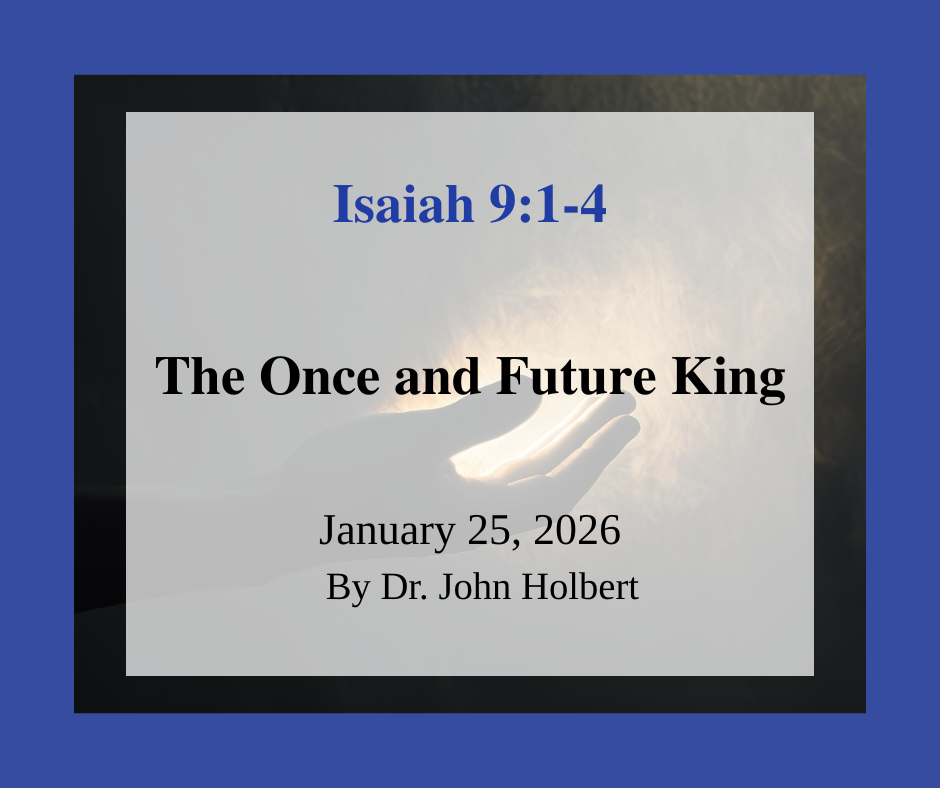The Once and Future King - Reflections on Isaiah 9:1-4, Third Sunday after Epiphany, Year A
by John C. Holbert on Saturday, November 15, 2025

We must begin by clearing up a bit of Hebrew/English versification confusion which occurs from time to time in moving from the ancient to the modern text. Is.9:1 in English translation is 8:23 in Hebrew, and thus the lectionary’s 9:1 is in fact really 8:23, and the pericope thus ends in Hebrew 9:3, English 9:4. Getting that difficulty out of the way does not answer the question of the refusal of the lectionary collectors to include the more famous part of Isaiah’s oracle, namely vss.5-7 (E), 4-6 (H). Handel’s “Messiah” has forever engraved those latter verses into our hearts, but we will not address them in this essay, but rather focus on the initial four verses of the text, a text that has long served as a description of the messianic king who is to come. For Christians, of course, that king is Jesus, born in Bethlehem.
As usual, as one of those who deeply values the historical context of the Hebrew Bible as it comes down to us, I want to be certain that I understand what Isaiah had in mind as he composed this text, before I turn to possible Christian uses of it. Isaiah makes the history that lies below his words quite plain in this instance, and our examination of that history helps us to understand more fully what the prophet implies here. Isaiah precedes this oracle with an attack on those in the land who have turned away from YHWH, and instead have “consulted ghosts and well-known spirits who chirp and mutter (both words are delightfully onomatopoeic verbs—hamzaphzmin and hammagim—difficult to translate into modern languages); why should the people not consult the dead on behalf of the living for Torah and teaching?” (Is.8:19-20). “Without a doubt, those who talk like that will see no dawn!” (Is.8:20).
A better time is coming, says Isaiah. “For there will be no gloom for those (formerly) in anguish” (Is.9:1). From here, Isaiah now directs his attention to his 8th century BCE historical context. Isaiah was living in the days of Assyrian ascendency. The expanding empire whose capital was Nineveh on the upper Tigris River began to be ruled by a series of kings whose sights were set squarely on Egypt, always the ancient Near East’s greatest prize. Of course, to get to Egypt, one had to go directly through the land of Palestine, first Israel in the north, then Judah in the south. Late in the 8th century the Assyrian Tiglath-Pileser raided into Syria and Palestine on his way to Egypt.
He first conquered Zebulon and Naphtali, two tribal areas connected to Israel in 733-732 BCE, along with “the way of the sea,” the coastal region south of Carmel, and “the land beyond the Jordan,” the area east of the Galilee. These references are to the beginning of the extermination of northern Israel, concluded in 722BCE. Isaiah says that the former destruction of these portions of the promised land will be restored by the appearance, under the aegis of YHWH, of a great king. Presumably for Isaiah this king is Hezekiah (715-687BCE), a well-known reformer, who sought during his long rulership to return the people to the worship of YHWH. It is he, says the prophet, who will bring light back to the land.
“The people who walked in darkness,
have seen a great light;
Those who lived in the land of deepest shadow,
a light has shown on them.
You have increased the nation,
made great its joy;
they have rejoiced before you
as one rejoices at harvest,
as people rejoice when dividing spoil” (Is.9:2; 9:3 English)
All of this will be a gift of the great king, Hezekiah, who appears to be the referent of the pronouns in the passage. Of course, Hezekiah will be able to accomplish this enlightening only through the power of YHWH and because the people have turned back to YHWH.
“For their burden’s yoke,
the slave bar across their shoulders,
the rod of their oppressors,
you have shattered as on the day of Midian” (Is.9:3; 9:4 English)
Isaiah promises that everything will be made new in this future time. Midian was long remembered as a thorn in the side of YHWH’s people, especially during the long-ago days of the judges (see Judges 6:1-8:28). All former oppressions and slavery will end. In fact, says the prophet, during the reign of the coming king:
“The boots of the tramping warriors,
all the garments rolled in blood,
shall be burned as fuel for fires” (Is.9:4; 9:5 English)
I add this verse as a graphic illustration of the huge gifts of the coming king. Not only will God’s people find new light, as well as freedom from oppression, but also war itself will end, as warriors’ boots and clothing of their wars shall serve now only as fuel for fires. The promise of the rule of Hezekiah is vast and wonderful! Unfortunately, none of Isaiah’s hopes came to fruition.
The early Christians seized this text and found in it the hopes of the birth of their Messiah, Jesus. New light, freedom from oppression, the end to the incessant wars and violence of the earth. Alas! That new hoped-for light is dim at best, always about to be extinguished by one army or another, one warrior or another, one ruler or another. Still, as Isaiah hoped, so did those early Christians, and so do we. The birth of Jesus rekindled those hopes, and each Epiphany season that hope springs forth once again. That is what we are called to proclaim once again this and every season; God is alive and active, despite what we can see, despite what the earthly powers continue to say.
